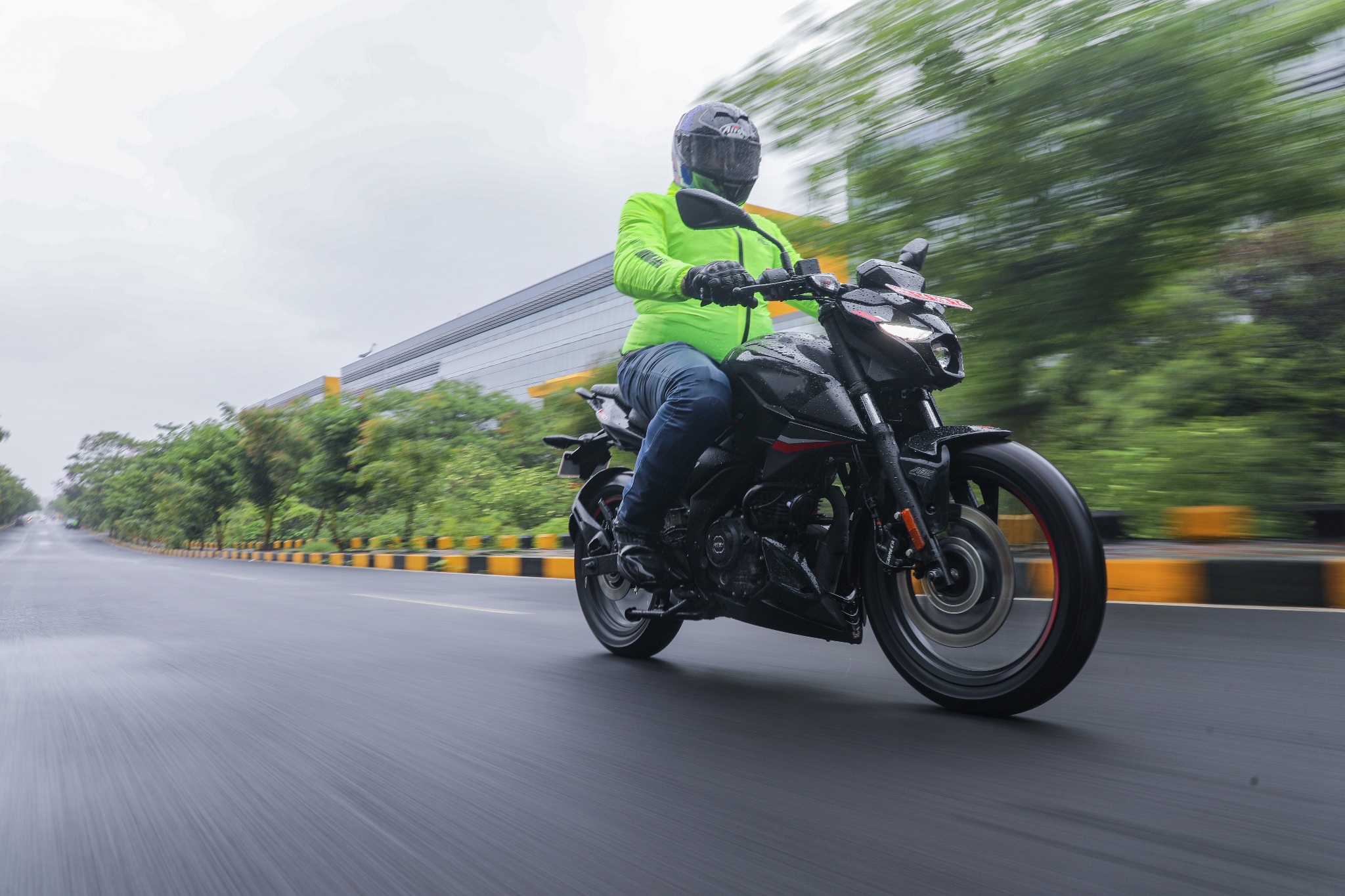Bajaj Pulsar N160 first ride review | The rival the TVS Apache RTR 160 4V never had?
Sharing the majority of its underpinnings, the Bajaj Pulsar N160 is the smaller sibling of the recently launched Pulsar N250
 The Bajaj Pulsar N160 is available with dual-channel ABS
The Bajaj Pulsar N160 is available with dual-channel ABSA new Pulsar is always an exciting proposition, and when it’s an all-new Pulsar, that just takes the excitement quotient one step further. The Pulsar N160 has been launched just some months after the launch of the all-new Pulsar F250 and N250. The N160 is a baby-naked iteration of the N250 with an all-new heart, that takes some underpinnings from the bigger sibling! What's the new N160 like? Read on to find out.
Bajaj Pulsar N160 design
 Headlamp and overall design identical to the Pulsar N250
Headlamp and overall design identical to the Pulsar N250The Bajaj Pulsar N250 is a striking bike with a well-proportioned design. The N160 by virtue of identical styling naturally draws this same praise. It gets the same LED projector headlamp, flanked by brow-shaped DRLs. As this is the naked model, it gets a flat handlebar, above which sits what Bajaj calls an 'infinity' instrument cluster, with its bezel-less design. All analogue junkies will love this display unit. Because, in today's times of fully-digital clusters, the N160 retains an analogue tachometer. Full marks for that. Apart from this, you also get your trip meter, speed, gear indicator and other crucial information. You also have a USB port, which for some is vital kit in this day and age. The fuel tank is chiseled and the overall gait of the bike is rather muscular, with a ‘pakka’ streetfighter stance. The split seat setup and tail section of the N160 remain identical to its bigger sibling. There are few distinguishing factors, however. First of which is the N160 badging. Then there are more subtle changes, like the traditional bulb-style turn signals over the LED units on 250 and the underbelly exhaust unlike the side-mounted end-can of the 250. We rode the top-end variant which gets dual-channel ABS and is currently only available in the 'Brooklyn Black' colourway. The blue and the red colours get single-channel ABS, a smaller front disc and skinnier 31mm front forks.
Bajaj Pulsar N160 engine
The Bajaj Pulsar N160 relies on an a four-stroke, 165cc, single-cylinder, air and oil cooled engine, with a two-valve head. In terms of output, the new Bajaj developed mill is good for 15.68bhp of power made at 8750rpm and 14.65Nm of torque that twists out at 6500rpm. Respectable for a bike of this class. But what’s it like in the real world? Thumb the starter and you are immediately greeted by a surprisingly baritone exhaust note that makes the N160 sound like it displaced a wee bit more cee’cees. A major takeaway I felt after riding the new Bajaj is how surprisingly refined it is. And this refinement stays a constant through any circumstance you throw it’s way. Considering we photographed this bike in continuous rainfall, I can’t really comment on what it would be like holding it at higher revs for a long duration in a cruising scenario, so I’ll reserve final judgment on that for the comprehensive road test. In terms of performance, the Pulsar N160 is rather spritely. There’s enough pep to keep those signal-to-signal drag races entertaining. The Bajaj engine also does well to feel extremely tractable, so you can almost always leave the bike in 1 gear higher than you should be in, and the N160 will still happily chug along, with no juddering whatsoever. In the little time I spent with the N160, I caught myself riding as slow as 30kmph in top gear and the bike did not mind this at all. This means, you don’t have to work your left foot nearly as much as you otherwise might have had to, riding your bike through city traffic.
 This five-speed gearbox is slick and tactile
This five-speed gearbox is slick and tactileAlthough, you wouldn’t mind shifting gears, thanks to a five-speed gearbox which is really slick, tactile and precise. Such an accomplished gearbox, combined with a perfectly weighted clutch, that torquey engine and supreme overall refinement make the N160 an extremely relaxing and stress-free Pulsar to ride. When you want to have some fun in the twisties, there’s enough punch in the mid-range for you to have a really good time. In a short stretch of an isolated, open road, I managed to clock 108kmph on the speedometer, with the N160 still accelerating fairly well. Bajaj also claims the new engine is good for close to a frugal 45kmpl, something that we think the N160 should easily be able to live up to, but do look forward to verifying properly in our upcoming road test.
Bajaj Pulsar N160 ride and handling
 The Pulsar N160 is agile and easy to maneuver
The Pulsar N160 is agile and easy to maneuverThe chassis of the top-end Pulsar N160 is identical to the Pulsar N250. The 160 also benefits weight reduction of almost 8kg in this dual-channel ABS variant, courtesy of the smaller engine. That, with the same chassis setup as the 250, makes this an agile bike, that’s easy to maneuver. This is also helped by the easily accessible 795mm seat height. The ride quality of the N160 is well sorted. The new Pulsar is set up to be comfortable and competent for city riding and the occasional spirited weekend rides. The bike handles bad roads, speed breakers and potholes with ample poise and composure, leaving you in control the whole time. In terms of handling, the bike feels extremely neutral and I mean this in the best way possible. The riding position is such that you maintain an upright, commuter friendly stance, with feet ever so slightly rearset. This rider's triangle gives you a commanding stance. The N160 offers predictable handling and cornering manners, throwing no random surprises your way. The chassis setup is relaxing. When you want to have some fun, the N160 lives up to its Pulsar nametag, making carving corners a fun affair. As we rode the bike exclusively in the rain, we can't tell you just yet all about the N160’s full handling potential, but what surprised me was the confidence the MRF Zapper-S tyres instilled. Despite an incessant downpour, the N160 gripped the tarmac well. Good tyres help the brakes and the Grimeca callipers perform well. With progressive, potent bite and all the feedback you need, the N160 brakes do a good job of shedding speed safely. Even the dual-channel ABS is well calibrated, so not once did I get any unsettling ABS feedback at the levers. One thing that would have made me enjoy the N160 ride more, would be a slightly wider handlebar, to give you better leverage over the bike.
Bajaj Pulsar N160 verdict
The dual-channel ABS variant of the Bajaj Pulsar N160 costs you Rs 1.28 lakh, before tax, and that in my opinion makes for great value. The N160 is the only bike in its class to get dual-channel ABS, which alone justifies the cost. That apart, you have a solid, well styled bike with a good chassis, potent, tractable engine and fine handling tying it all together. If you are in the market for an affordable, well put together motorcycle that takes care of all your commuting needs and lets you blow off some weekend steam, I would definitely recommend the N160. In terms of rivals, there’s the TVS Apache RTR 160 4V, the Suzuki Gixxer 150 and Hero Xtreme 160R which relative to the N160, quite frankly feel pretty dated. How it performs against the current favourite - the Apache RTR 160 4V is something we are keen to find out. So stay tuned for our comparison test!


